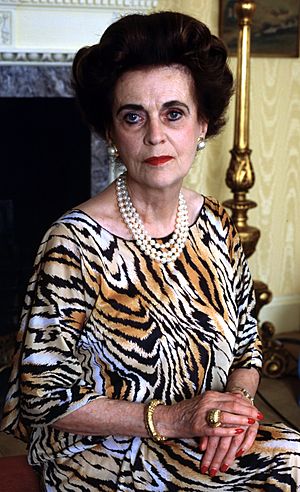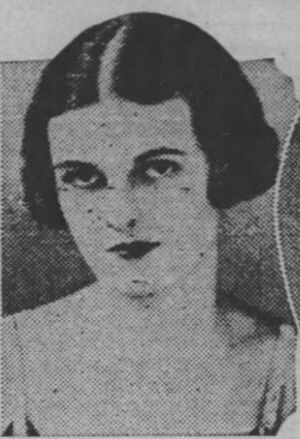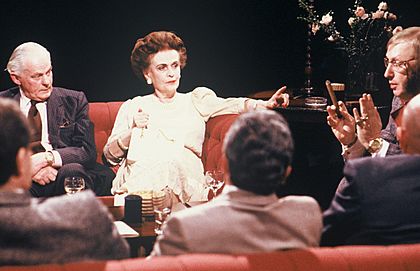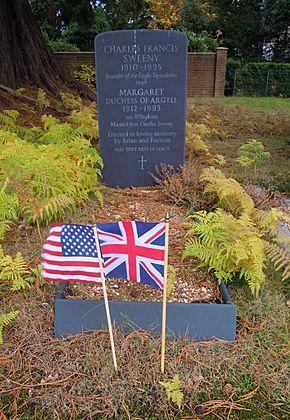Margaret Campbell, Duchess of Argyll facts for kids
Quick facts for kids
Margaret, Duchess of Argyll
|
|
|---|---|

Portrait by Allan Warren, 1991
|
|
| Personal details | |
| Born |
Ethel Margaret Whigham
1 December 1912 Newton Mearns, Renfrewshire, Scotland, UK |
| Died | 25 July 1993 (aged 80) Pimlico, London, England, UK |
| Resting place | Brookwood Cemetery, Surrey, England |
| Spouses |
|
| Children | 3, including Frances, Duchess of Rutland |
| Parents |
|
| Relatives | Jane Beadon (stepmother) |
Ethel Margaret Campbell, Duchess of Argyll (born Whigham, formerly Sweeny; 1 December 1912 – 25 July 1993) was a Scottish heiress and well-known socialite. She was famous for her marriage in 1951 and her much-talked-about divorce in 1963 from her second husband, Ian Campbell, 11th Duke of Argyll.
Contents
Early Life and Education
Margaret Whigham was the only child of Helen Mann Hannay and George Hay Whigham. Her father was a successful businessman and chairman of the Celanese Corporation. He became a millionaire on his own.
Margaret spent her early years, until she was fourteen, in New York City. She received private lessons at the Hewitt School. People often spoke about her beauty. As a young woman, she had friendships with notable figures like Prince Aly Khan and Max Aitken.
In 1930, Margaret was formally introduced to society at the Queen Charlotte's Ball in London. She was known as the most popular debutante of that year. She was briefly engaged to Charles Guy Fulke Greville, 7th Earl of Warwick. However, she later chose to marry Charles Francis Sweeny.
First Marriage and Family
On 21 February 1933, Margaret married Charles Francis Sweeny, an American businessman. Their wedding took place at the Brompton Oratory in London. Margaret's Norman Hartnell wedding dress was so famous that it caused traffic jams in Knightsbridge.
Throughout her life, Margaret was known for her glamorous and elegant style. She was a loyal customer of top fashion designers like Norman Hartnell. She was also photographed as classical figures by the famous photographer Madame Yevonde.
Margaret had three children with Charles Sweeny:
- A daughter who was stillborn in 1933.
- A daughter, Frances Helen (born 1937). Frances later married Charles Manners, 10th Duke of Rutland.
- A son, Brian Charles (born 1940).
In 1943, Margaret had a serious accident. She fell about 12 meters (40 feet) down a lift shaft. She believed that the lift cable saved her life by breaking her fall.
Life Between Marriages
Margaret and Charles Sweeny divorced in 1947. After her first marriage ended, Margaret was briefly engaged to a banker named Joseph Thomas. However, he fell in love with someone else, and the engagement ended.
She also had a serious relationship with Theodore Rousseau, a curator at the Metropolitan Museum of Art. Margaret described him as very smart and confident. This relationship also ended, as she felt he might not be the right stepfather for her children.
Second Marriage
On 22 March 1951, Margaret became the third wife of Ian Douglas Campbell, 11th Duke of Argyll. The Duke was a Scottish nobleman.
Margaret was even mentioned in a famous song. The lyrics of "You're the Top" were changed for the British version by P. G. Wodehouse. He included the line, "You're Mrs Sweeny," referring to Margaret.
Divorce from the Duke of Argyll
After a few years, Margaret's second marriage began to face difficulties. The divorce proceedings were very public and received a lot of attention. The Duke made many accusations against Margaret during the divorce. The court case was widely reported in newspapers.
The Duchess never publicly shared certain details about the divorce. She continued to live her life in the public eye.
Later Years
Margaret wrote a book about her life called Forget Not, which was published in 1975. She also wrote a guide on how to entertain guests. Her London home, which was beautifully decorated, was opened for paid tours.
Over time, Margaret's money decreased due to her expensive lifestyle and some poor investments. In 1978, she had to move from her large house to a suite at the Grosvenor House Hotel. In 1990, she could no longer afford the hotel and moved into an apartment with help from friends and her first husband.
Later, Margaret's children helped her move into a nursing home in Pimlico, London. She passed away in 1993 after a fall at the nursing home. Her funeral was held at the Church of the Immaculate Conception, Farm Street. She was buried next to her first husband, Charles Sweeny, at Brookwood Cemetery in Woking, Surrey.
A book about Margaret's life, The Duchess Who Dared, was written by Charles Castle and published in 1994.
Personality and Style
Margaret, Duchess of Argyll, was known for her strong personality and unique style. She once told The New York Times, "I don't think anybody has real style or class any more. Everyone's got old and fat."
She described herself as "always vain." She also famously said, "Always a poodle, only a poodle! That, and three strands of pearls! Together they are absolutely the essential things in life." This quote shows her love for luxury and her distinctive taste.
Images for kids
-
Margaret's wedding dress for her marriage to Charles Sweeny in 1933, designed by Norman Hartnell. It was made of silk satin and tulle embroidered with glass beads, with a 2.6-metre train. Victoria and Albert Museum, London





